英语中感官动词的用法
- 格式:doc
- 大小:17.00 KB
- 文档页数:2
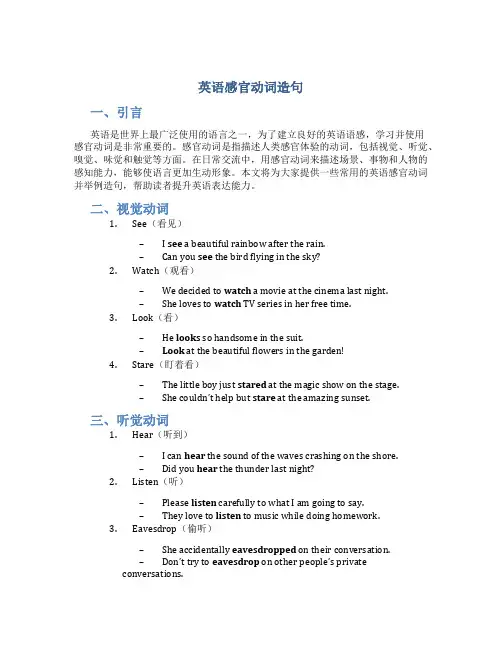
英语感官动词造句一、引言英语是世界上最广泛使用的语言之一,为了建立良好的英语语感,学习并使用感官动词是非常重要的。
感官动词是指描述人类感官体验的动词,包括视觉、听觉、嗅觉、味觉和触觉等方面。
在日常交流中,用感官动词来描述场景、事物和人物的感知能力,能够使语言更加生动形象。
本文将为大家提供一些常用的英语感官动词并举例造句,帮助读者提升英语表达能力。
二、视觉动词1.See(看见)–I see a beautiful rainbow after the rain.–Can you see the bird flying in the sky?2.Watch(观看)–We decided to watch a movie at the cinema last night.–She loves to watch TV series in her free time.3.Look(看)–He looks so handsome in the suit.–Look at the beautiful flowers in the garden!4.Stare(盯着看)–The little boy just stared at the magic show on the stage.–She couldn’t help but stare at the amazing sunset.三、听觉动词1.Hear(听到)–I can hear the sound of the waves crashing on the shore.–Did you hear the thunder last night?2.Listen(听)–Please listen carefully to what I am going to say.–They love to listen to music while doing homework.3.Eavesdrop(偷听)–She accidentally eavesdropped on their conversation.–Don’t try to eavesdrop on other people’s privateconversations.4.Overhear(无意中听到)–I overheard him talking about his travel plans.–They were shocked when they overheard their neighbors arguing.四、嗅觉动词1.Smell(闻)–I love the smell of freshly baked bread.–Can you smell the scent of flowers in the garden?2.Sniff(嗅)–The dog sniffed around the room, searching for food.–She sniffed the perfume to see if she liked it.3.Scent(嗅到)–The hunter could sense the scent of the prey nearby.–The bakery is filled with the scent of freshly brewed coffee.4.Inhale(吸入)–She closed her eyes and inhaled the refreshing ocean breeze.–It’s important to inhale deeply when practicing yoga.五、味觉动词1.Taste(尝)–The soup tastes very delicious.–Have you tasted the new flavor of ice cream?2.Try(尝试)–He decided to try the spicy food even though he couldn’t handle it.–Don’t forget to try the local cuisine when you travel.3.Savor(品味)–She savored every bite of the chocolate cake.–Take your time to savor the flavors of the dish.4.Sample(品尝)–The waiter offered to sample the different wines before ordering.–They sampled various types of cheese during the tasting event.六、触觉动词1.Touch(触摸)–The soft fur made her want to touch the cute little puppy.–She hesitated to touch the prickly cactus.2.Feel(感受)–We all feel excited about the upcoming vacation.–Can you feel the warmth of the sun on your skin?3.Hold(握住)–He gently held her hand as they walked along the beach.–The child held the balloon tightly, afraid of letting it go.4.Embrace(拥抱)–They finally met after a long time and shared a warm embrace.–The mother embraced her child tightly to show her love.七、结论通过运用感官动词,我们可以更加生动地描述我们与世界的感知和互动。

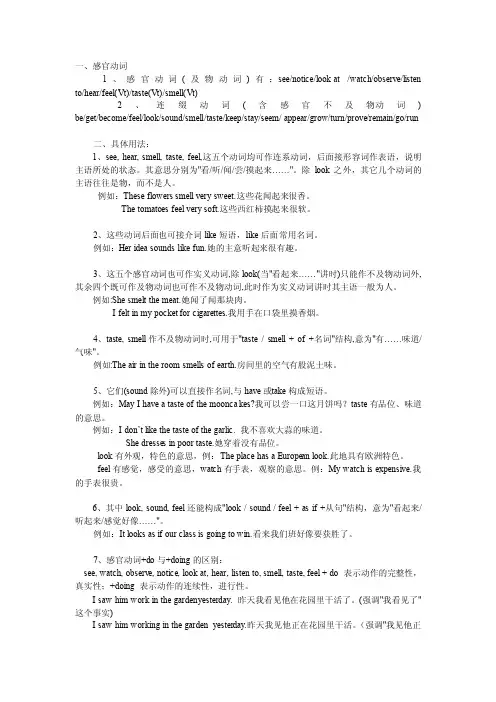
一、感官动词1、感官动词(及物动词)有:see/notice/look at/watch/observe/listento/hear/feel(Vt)/taste(Vt)/smell(Vt)2、连缀动词(含感官不及物动词) be/get/become/feel/look/sound/smell/taste/keep/stay/seem/ appear/grow/turn/prove/remain/go/run二、具体用法:1、see, hear, smell, taste, feel,这五个动词均可作连系动词,后面接形容词作表语,说明主语所处的状态。
其意思分别为"看/听/闻/尝/摸起来……"。
除look之外,其它几个动词的主语往往是物,而不是人。
例如:These flowers smell very sweet.这些花闻起来很香。
The tomatoe s feel very soft.这些西红柿摸起来很软。
2、这些动词后面也可接介词li ke短语,like后面常用名词。
例如:Her idea soundslike fun.她的主意听起来很有趣。
3、这五个感官动词也可作实义动词,除look(当"看起来……"讲时)只能作不及物动词外,其余四个既可作及物动词也可作不及物动词,此时作为实义动词讲时其主语一般为人。
例如:She smelt the meat.她闻了闻那块肉。
I felt in my pocketfor cigaret tes.我用手在口袋里摸香烟。
4、taste, smell作不及物动词时,可用于"taste / smell + of +名词"结构,意为"有……味道/气味"。
例如:The air in the room smellsof earth.房间里的空气有股泥土味。
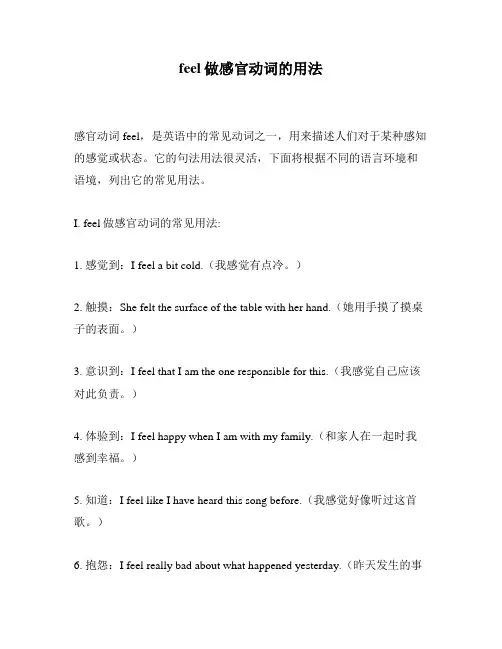
feel做感官动词的用法感官动词feel,是英语中的常见动词之一,用来描述人们对于某种感知的感觉或状态。
它的句法用法很灵活,下面将根据不同的语言环境和语境,列出它的常见用法。
I. feel做感官动词的常见用法:1. 感觉到:I feel a bit cold.(我感觉有点冷。
)2. 触摸:She felt the surface of the table with her hand.(她用手摸了摸桌子的表面。
)3. 意识到:I feel that I am the one responsible for this.(我感觉自己应该对此负责。
)4. 体验到:I feel happy when I am with my family.(和家人在一起时我感到幸福。
)5. 知道:I feel like I have heard this song before.(我感觉好像听过这首歌。
)6. 抱怨:I feel really bad about what happened yesterday.(昨天发生的事情让我感到很糟糕。
)7. 判断:From her tone of voice, I feel that she is not happy.(从她的语气来判断,我感觉她不高兴。
)8. 猜想:I feel that he might be lying.(我猜他可能在说谎。
)II. feel作为不及物动词时的常见用法:1. 感到:I feel happy.(我感觉很快乐。
)2. 检查:Can you feel if there is any pulse?(你能检查下有没有脉搏吗?)3. 试探:I need to feel him out before I make any decision.(我需要试探一下他才能做出任何决定。
)4. 穿戴:I feel comfortable in these clothes.(穿这些衣服我觉得很舒服。
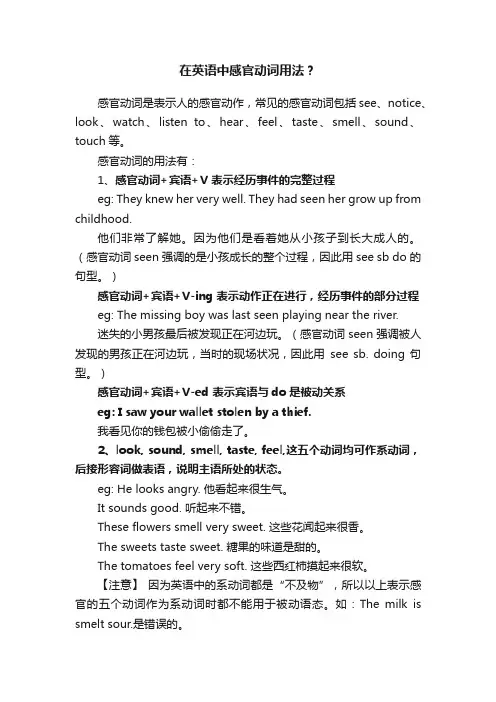
在英语中感官动词用法?感官动词是表示人的感官动作,常见的感官动词包括see、notice、look、watch、listen to、hear、feel、taste、smell、sound、touch等。
感官动词的用法有:1、感官动词+宾语+V 表示经历事件的完整过程eg: They knew her very well. They had seen her grow up from childhood.他们非常了解她。
因为他们是看着她从小孩子到长大成人的。
(感官动词seen强调的是小孩成长的整个过程,因此用see sb do 的句型。
)感官动词+宾语+V-ing 表示动作正在进行,经历事件的部分过程eg: The missing boy was last seen playing near the river.迷失的小男孩最后被发现正在河边玩。
(感官动词seen强调被人发现的男孩正在河边玩,当时的现场状况,因此用see sb. doing 句型。
)感官动词+宾语+V-ed 表示宾语与do是被动关系eg: I saw your wallet stolen by a thief.我看见你的钱包被小偷偷走了。
2、look, sound, smell, taste, feel,这五个动词均可作系动词,后接形容词做表语,说明主语所处的状态。
eg: He looks angry. 他看起来很生气。
It sounds good. 听起来不错。
These flowers smell very sweet. 这些花闻起来很香。
The sweets taste sweet. 糖果的味道是甜的。
The tomatoes feel very soft. 这些西红柿摸起来很软。
【注意】因为英语中的系动词都是“不及物”,所以以上表示感官的五个动词作为系动词时都不能用于被动语态。
如:The milk is smelt sour.是错误的。
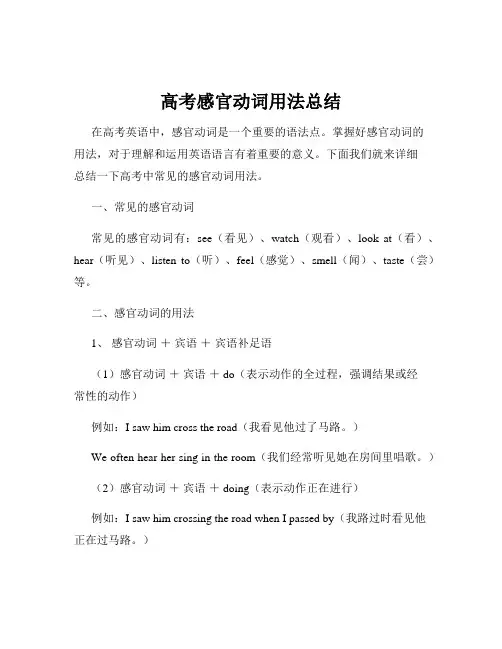
高考感官动词用法总结在高考英语中,感官动词是一个重要的语法点。
掌握好感官动词的用法,对于理解和运用英语语言有着重要的意义。
下面我们就来详细总结一下高考中常见的感官动词用法。
一、常见的感官动词常见的感官动词有:see(看见)、watch(观看)、look at(看)、hear(听见)、listen to(听)、feel(感觉)、smell(闻)、taste(尝)等。
二、感官动词的用法1、感官动词+宾语+宾语补足语(1)感官动词+宾语+ do(表示动作的全过程,强调结果或经常性的动作)例如:I saw him cross the road(我看见他过了马路。
)We often hear her sing in the room(我们经常听见她在房间里唱歌。
)(2)感官动词+宾语+ doing(表示动作正在进行)例如:I saw him crossing the road when I passed by(我路过时看见他正在过马路。
)I heard her singing in the room at that time(那时我听见她正在房间里唱歌。
)(3)感官动词+宾语+ done(表示宾语与宾语补足语之间是被动关系)例如:I saw the window broken(我看见窗户被打破了。
)We found the tree cut down(我们发现树被砍倒了。
)2、感官动词+宾语从句例如:I saw that he crossed the road safely(我看见他安全地过了马路。
)She heard that someone was knocking at the door(她听见有人在敲门。
)3、感官动词的被动语态感官动词在被动语态中,其后的宾语补足语要用带 to 的不定式。
例如:He was seen to cross the road(有人看见他过了马路。
)The girl was heard to sing in the room(有人听见这个女孩在房间里唱歌。

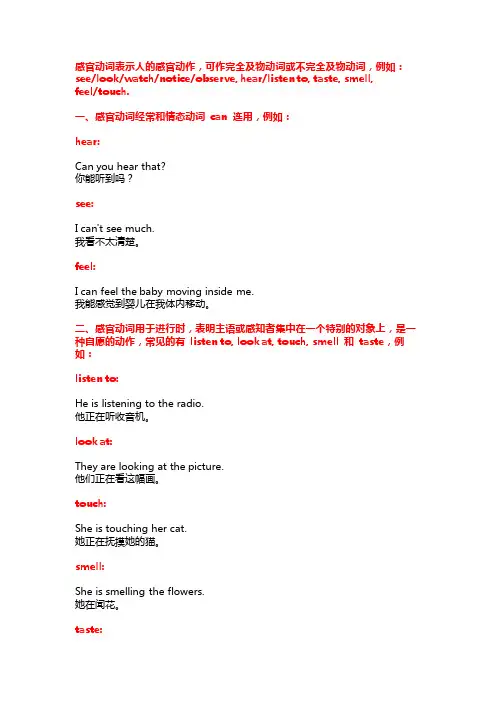
感官动词表示人的感官动作,可作完全及物动词或不完全及物动词,例如:see/look/watch/notice/observe, hear/listen to, taste, smell,feel/touch.一、感官动词经常和情态动词can 连用,例如:hear:Can you hear that?你能听到吗?see:I can't see much.我看不太清楚。
feel:I can feel the baby moving inside me.我能感觉到婴儿在我体内移动。
二、感官动词用于进行时,表明主语或感知者集中在一个特别的对象上,是一种自愿的动作,常见的有listen to, look at, touch, smell 和taste,例如:listen to:He is listening to the radio.他正在听收音机。
look at:They are looking at the picture.他们正在看这幅画。
touch:She is touching her cat.她正在抚摸她的猫。
smell:She is smelling the flowers.她在闻花。
taste:We are tasting champagne.我们正在品尝香槟。
并不是所有的感官动词都可以用进行时,例如:误:She was hearing a noise.误:He was seeing a woman in the rain.但当hear 在表达一种经历时,可以用进行时;see 在表达与人见面或是约会,可以用进行时,等等,例如:hearing:She was always hearing voices in her head.她脑子里总有声音。
seeing:She is seeing the doctor.她正在看医生。
He was seeing another woman.他在和另一个女人约会。
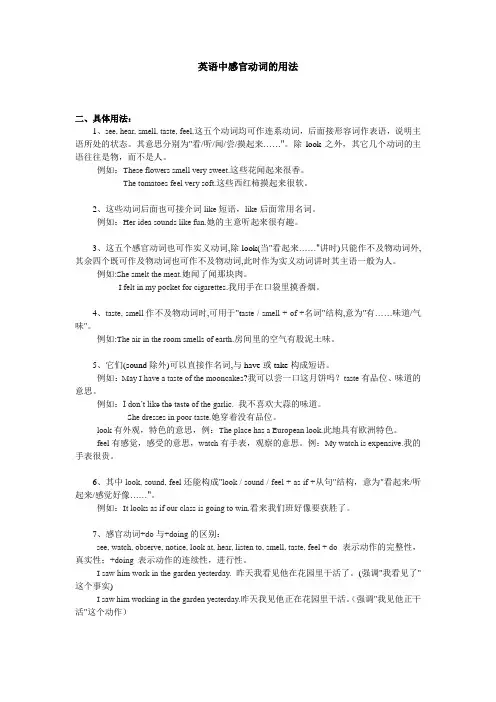
英语中感官动词的用法二、具体用法:1、see, hear, smell, taste, feel,这五个动词均可作连系动词,后面接形容词作表语,说明主语所处的状态。
其意思分别为"看/听/闻/尝/摸起来……"。
除look之外,其它几个动词的主语往往是物,而不是人。
例如:These flowers smell very sweet.这些花闻起来很香。
The tomatoes feel very soft.这些西红柿摸起来很软。
2、这些动词后面也可接介词like短语,like后面常用名词。
例如:Her idea sounds like fun.她的主意听起来很有趣。
3、这五个感官动词也可作实义动词,除look(当"看起来……"讲时)只能作不及物动词外,其余四个既可作及物动词也可作不及物动词,此时作为实义动词讲时其主语一般为人。
例如:She smelt the meat.她闻了闻那块肉。
I felt in my pocket for cigarettes.我用手在口袋里摸香烟。
4、taste, smell作不及物动词时,可用于"t aste / smell + of +名词"结构,意为"有……味道/气味"。
例如:The air in the room smells of earth.房间里的空气有股泥土味。
5、它们(sound除外)可以直接作名词,与have或take构成短语。
例如:May I have a taste of the mooncakes?我可以尝一口这月饼吗?taste有品位、味道的意思。
例如:I don’t like the taste of the garlic.我不喜欢大蒜的味道。
She dresses in poor taste.她穿着没有品位。
look有外观,特色的意思,例:The place has a European look.此地具有欧洲特色。
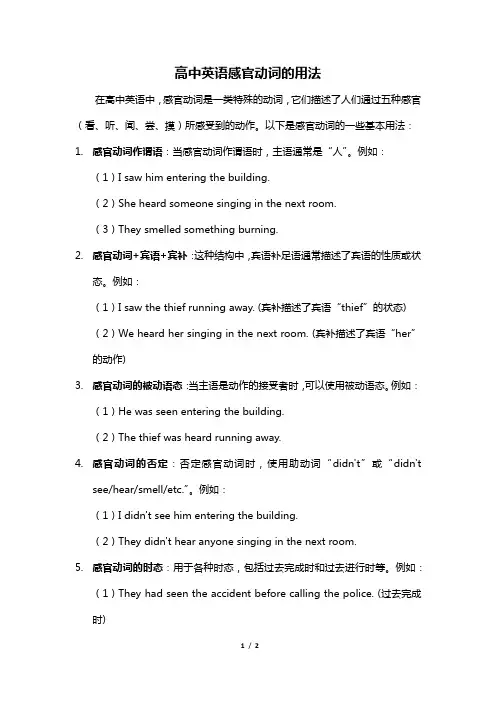
高中英语感官动词的用法在高中英语中,感官动词是一类特殊的动词,它们描述了人们通过五种感官(看、听、闻、尝、摸)所感受到的动作。
以下是感官动词的一些基本用法:1.感官动词作谓语:当感官动词作谓语时,主语通常是“人”。
例如:(1)I saw him entering the building.(2)She heard someone singing in the next room.(3)They smelled something burning.2.感官动词+宾语+宾补:这种结构中,宾语补足语通常描述了宾语的性质或状态。
例如:(1)I saw the thief running away. (宾补描述了宾语“thief”的状态) (2)We heard her singing in the next room. (宾补描述了宾语“her”的动作)3.感官动词的被动语态:当主语是动作的接受者时,可以使用被动语态。
例如:(1)He was seen entering the building.(2)The thief was heard running away.4.感官动词的否定:否定感官动词时,使用助动词“didn't”或“didn'tsee/hear/smell/etc.”。
例如:(1)I didn't see him entering the building.(2)They didn't hear anyone singing in the next room.5.感官动词的时态:用于各种时态,包括过去完成时和过去进行时等。
例如:(1)They had seen the accident before calling the police. (过去完成时)(2)She was seeing a movie when the power went out. (过去进行时) 高中英语中的感官动词主要用于描述人们通过五感所感知到的动作和状态。
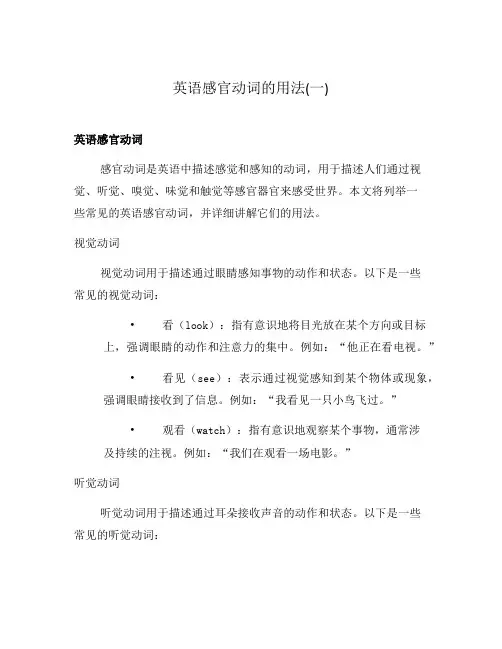
英语感官动词的用法(一)英语感官动词感官动词是英语中描述感觉和感知的动词,用于描述人们通过视觉、听觉、嗅觉、味觉和触觉等感官器官来感受世界。
本文将列举一些常见的英语感官动词,并详细讲解它们的用法。
视觉动词视觉动词用于描述通过眼睛感知事物的动作和状态。
以下是一些常见的视觉动词:•看(look):指有意识地将目光放在某个方向或目标上,强调眼睛的动作和注意力的集中。
例如:“他正在看电视。
”•看见(see):表示通过视觉感知到某个物体或现象,强调眼睛接收到了信息。
例如:“我看见一只小鸟飞过。
”•观看(watch):指有意识地观察某个事物,通常涉及持续的注视。
例如:“我们在观看一场电影。
”听觉动词听觉动词用于描述通过耳朵接收声音的动作和状态。
以下是一些常见的听觉动词:•听(listen):指有意识地接收声音,通常涉及专注和用心倾听。
例如:“他正在听音乐。
”•听到(hear):表示通过听觉感知到声音,强调耳朵接收到了信息。
例如:“我听到有人敲门。
”•倾听(attend):指专心地听某人讲话或某个声音,通常涉及配合眼神或姿势表达出对信息的注意。
例如:“她倾听着老师的讲解。
”嗅觉动词嗅觉动词用于描述通过鼻子嗅到气味的动作和状态。
以下是一些常见的嗅觉动词:•闻(smell):指有意识地嗅到气味,强调鼻子接收到了信息。
例如:“我闻到了鲜花的香味。
”•嗅到(detect):表示通过嗅觉感知到某种气味,强调鼻子接收到了信息。
例如:“狗的嗅觉比人敏锐,可以嗅到地底下的气味。
”•嗅觉敏锐(have a keen sense of smell):表示某人嗅觉灵敏,能够辨别出不同的气味。
例如:“猎犬具有嗅觉敏锐的特点。
”味觉动词味觉动词用于描述通过舌头尝到味道的动作和状态。
以下是一些常见的味觉动词:•尝(taste):指有意识地品尝食物或液体,强调舌头接收到了味道的信息。
例如:“他尝了一口咖啡。
”•感到苦(taste bitter):表示尝到苦味,强调味觉感受。
5个感官动词及其它们用法作为人类的五个感官,视觉、听觉、触觉、嗅觉和味觉都是一种非常重要的感知方式,它们有着广泛的应用范围。
在英语语言中,与这些感官相关的动词有很多,这些动词不仅可以描述人们的感知过程,还可以用于形容事物的外观,声音,质感,气味和味道。
接下来,本文将介绍几个最常见的感官动词及其它他们的使用方式。
1. LookLook是“看”的意思,它可以用于描述人们的视觉感知和事物的外观。
例如,当你要表达你的外貌或某个人的外貌时,可以使用look这个词。
另外,这个词还可以用于描述景象的美丑,可爱或可怕,它的修饰语可以是形容词或介词短语,如:- You look beautiful in that dress.(穿那件连衣裙你看起来非常漂亮) - The sunset looks spectacular.(那个日落看起来很壮观) - The apartment looks cozy and comfortable.(那个公寓看起来非常舒适)2. HearHear是“听”的意思,它可以用于描述人们的听觉感知和事物的声音。
例如,当你要描述某个人说话的声音,或某个地方的环境声音时,可以使用hear这个词。
此外,hear还可以用于表达听到某种消息,声音或音乐,例如:- I heard a strange noise outside my house.(我听到了我房子外面的奇怪的声音) - She heard that her favorite band was coming to town.(她听到她最喜欢的乐队要来城里演出) - Can you hear me?(你能听到我说话吗?)3. TouchTouch是“触摸”的意思,它可以用于描述人们的触觉感知和事物的质地或纹理。
例如,当你要描述某件物品的表面感觉时,可以使用touch这个词。
它也可以用于表达接触到某物体的真实感受。
以下是例句:- The fabric of the dress feels soft to the touch.(这件衣服的面料摸起来很软) - The water in the pool is refreshing to the touch.(池子里的水感觉清凉) - The surface of the table is rough to the touch. (桌子的表面摸起来很粗糙)4. SmellSmell是“嗅”的意思,它可以用于描述人们的嗅觉感知和事物的气味。
高中英语知识点归纳情感动词和感官动词的用法高中英语知识点归纳:情感动词和感官动词的用法情感动词和感官动词在英语中是一类非常常用的动词,它们用来描述人们的情感和感觉。
在高中英语的学习中,掌握情感动词和感官动词的正确用法对于提高语言表达能力非常重要。
下面是对这两类动词用法进行的详细归纳:一、情感动词的用法1. like- 表示喜欢或偏爱某人或某物- 例如: I like the color blue.(我喜欢蓝色。
)2. love- 表示强烈的喜爱、热爱- 例如: She loves to sing.(她热爱唱歌。
)3. enjoy- 表示享受某种活动或事物- 例如: We enjoy playing basketball.(我们喜爱打篮球。
)4. hate- 表示憎恨或极其讨厌- 例如: He hates studying late at night.(他讨厌晚上学习。
)5. prefer- 表示更喜欢或更青睐- 例如: I prefer tea to coffee.(我更喜欢茶而不是咖啡。
)6. fear- 表示害怕或恐惧- 例如: They fear to fail the exam.(他们害怕考试不及格。
)二、感官动词的用法1. see- 表示看到或注意到- 例如: I see a cat in the garden.(我在花园里看到一只猫。
)2. watch- 表示观看或注视- 例如: We watch movies every weekend.(我们每个周末看电影。
)3. hear- 表示听到某人说话或声音- 例如: I heard someone calling my name.(我听到有人在叫我的名字。
)4. listen- 表示倾听或聆听- 例如: Please listen to me carefully.(请仔细听我说。
)5. feel- 表示感触或感觉- 例如: I feel happy today.(我今天感到很开心。
初二感官动词的用法在初二英语的学习中,感官动词是一个重要的语法点。
掌握好感官动词的用法,对于提高英语语言的理解和表达能力有着至关重要的作用。
首先,让我们来了解一下什么是感官动词。
感官动词是指与我们的五种感官(视觉、听觉、嗅觉、味觉、触觉)相关的动词,常见的感官动词有 look(看起来)、sound(听起来)、smell(闻起来)、taste (尝起来)、feel(感觉;摸起来)。
一、感官动词的基本用法1、感官动词+形容词这是感官动词最常见的用法之一。
例如:“The cake tastes delicious”(这个蛋糕尝起来很美味。
)“The music sounds wonderful”(这音乐听起来很棒。
)“The flower smells sweet”(这花闻起来很香。
)“The silk feels soft”(这丝绸摸起来很柔软。
)“She looks beautiful”(她看起来很漂亮。
)需要注意的是,这里的形容词是用来描述主语给人的感觉或特征的。
2、感官动词+ like +名词这种结构表示“看起来/听起来/闻起来/尝起来/摸起来像”。
比如:“It looks like a bird”(它看起来像一只鸟。
)“This song sounds like a folksong”(这首歌听起来像一首民歌。
)“The dish smells like fish”(这道菜闻起来像鱼。
)“The drink tastes like juice”(这饮料尝起来像果汁。
)“The stone feels like a ball”(这块石头摸起来像一个球。
)二、感官动词的实义动词用法1、 look当 look 表示“看;瞧”这一实义动作时,其后要接宾语,通常要与介词 at 连用。
例如:“Look at the blackboard, please”(请看黑板。
)2、 feelfeel 作为实义动词时,可以表示“触摸;摸索”等意思。
英语感官动词的用法英语中的感官动词用于描述我们的感官体验,包括视觉、听觉、嗅觉、味觉和触觉。
以下是一些常见的感官动词及其用法:1. See(看到):- I see a beautiful sunset.(我看到了一道美丽的日落。
)- Can you see the bird in the tree?(你能看到树上的鸟吗?)2. Watch(观看):- Let's watch a movie tonight.(今晚我们一起看电影吧。
)- He watched the soccer game on TV.(他在电视上观看了足球比赛。
)3. Hear(听到):- I can hear the music playing in the background.(我能听到背景中播放的音乐。
) - Did you hear what she said?(你听到她说的话了吗?)4. Listen(听):- Please listen to me carefully.(请仔细听我说。
)- She likes to listen to classical music.(她喜欢听古典音乐。
)5. Smell(闻到):- I can smell the fresh flowers.(我能闻到新鲜的花香。
)- The bakery smells like freshly baked bread.(面包店闻起来像刚出炉的面包。
)6. Taste(尝到):- This soup tastes delicious.(这碗汤尝起来很美味。
)- Have you ever tasted sushi?(你尝过寿司吗?)7. Touch(触摸):- The fabric feels soft and smooth.(这块布料摸起来柔软光滑。
)- He reached out and touched the cold surface.(他伸手触摸了那个冰冷的表面。
感官动词的用法总结感官动词的用法总结感官动词是表示某种感受的词,它在日常英语中很常见,具有十分重要的语法作用。
它们一般用来指代人的视、听、嗅、味、触等感官发出的信号,这些信号反映在人的感觉器官上,形成一种特定的感觉。
在日常英语中,有一些常用的感官动词,如:see,hear,smell,taste,feel,watch,listen,notice,observe等。
一、See“see”的基本意思是“看”,它可以用来表示看到某物,也可以用来表示看到某种状态,例如:I see a black cat on the wall.我看到墙上有一只黑色猫。
I see what you mean.我明白你的意思了。
它也可以表示观察某种情况,例如:I saw a man walking in the rain.我看到一个人正在下雨中行走。
也可以用来表示注意到某种变化,例如:I saw the market change a lot.我看到市场变化很大。
二、Hear“hear”的基本意思是“听”,它可以用来表示听见某种声音,例如:I heard a loud voice.我听到一个大声的声音。
也可以表示听到某人说的话,例如:I heard him say he is going to leave.我听他说他要离开了。
它还可以表示听到关于某件事的消息,例如:I heard the news about the earthquake.我听说了有关地震的消息。
三、Smell“smell”的基本意思是“闻”,它可以表示闻到某种气味,例如: I smell something burning.我闻到有什么东西在烧。
也可以表示闻到某种气味,例如:I smell the scent of roses.我闻到蔷薇的芳香。
它也可以用来表示嗅出某种气味,例如:I smelled something strange in the air.空气中有一种奇怪的味道。
感官动词及感官动词非谓语形式的用法详解一、什么是感官动词?英语语法中的感官动词指的是用来描述人或动物的五种感觉(视觉、听觉、嗅觉、味觉和触觉)的动词,如看、听、闻、尝、感等。
这些动词通常与名词一起使用,表示人或动物对外界事物的感知和体验。
常见的英语感官动词包括:1. seem/see/watch (看)2. sound/hear (听)3. smell (闻)4. taste (尝)5.look (看)6. feel (感觉)二、什么是非谓语动词?非谓语动词是指没有主语和谓语的动词形式,通常作为句子中的修饰成分。
它们可以分为三种形式:不定式、动名词和分词。
不定式(Infinitive):由“to + 动词原形”构成,例如:to eat, to sleep, to study。
它通常用作名词、形容词或副词的补足语。
动名词(Gerund):由动词原形加上-ing构成,例如:eating, sleeping, studying。
它通常用作主语、宾语、表语或介词后的宾语。
分词(Participle):分为现在分词和过去分词两种形式,分别以-ing和-ed结尾。
现在分词通常用作形容词或副词的补足语,过去分词通常用作定语、状语或被动语态中的谓语动词。
三、什么是感官动词的非谓语形式?英语语法中的感官动词非谓语形式指的是将感官动词转化为不定式、动名词或分词等非谓语动词形式。
其中,感官动词非谓语形式中的不定式往往表示将要发生的动作或目的,动名词表示某人或某物的状态或特征,现在分词表主动或正在进行的动作,过去分词则表示被动或被动完成的动作。
举例说明如下:feel的动名词形式为feeling,常用于表示某人或某物的状态或特征。
例如:His feelings for her are strong.(他对她的感情很强烈。
)look的不定式形式为to look,常用于表示将要发生的动作或目的。
例如:I need to look for my keys before I leave.(我离开前需要找我的钥匙。
英语中感官动词的用法
一、感官动词
1、感官动词(及物动词)有:see/notice/look at/watch/observe/listen
to/hear/feel(Vt)/taste(Vt)/smell(Vt)
2、连缀动词(含感官不及物动词)
be/get/become/feel/look/sound/smell/taste/keep/stay/seem/ appear/grow/turn/prove/remain/go/run
二、具体用法:
1、see, hear, smell, taste, feel,这五个动词均可作连系动词,后面接形容词作表语,说明主语所处的状态。
其意思分别为"看/听/闻/尝/摸起来……"。
除look之外,其它几个动词的主语往往是物,而不是人。
例如:These flowers smell very sweet.这些花闻起来很香。
The tomatoes feel very soft.这些西红柿摸起来很软。
2、这些动词后面也可接介词like短语,like后面常用名词。
例如:Her idea sounds like fun.她的主意听起来很有趣。
3、这五个感官动词也可作实义动词,除look(当"看起来……"讲时)只能作不及物动词外,其余四个既可作及物动词也可作不及物动词,此时作为实义动词讲时其主语一般为人。
例如:She smelt the meat.她闻了闻那块肉。
I felt in my pocket for cigarettes.我用手在口袋里摸香烟。
4、taste, smell作不及物动词时,可用于"t aste / smell + of +名词"结构,意为"有……味道/气味"。
例如:The air in the room smells of earth.房间里的空气有股泥土味。
5、它们(sound除外)可以直接作名词,与have或take构成短语。
例如:May I have a taste of the mooncakes?我可以尝一口这月饼吗?taste有品位、味道的意思。
例如:I don’t like the taste of the garlic.我不喜欢大蒜的味道。
She dresses in poor taste.她穿着没有品位。
look有外观,特色的意思,例:The place has a European look.此地具有欧洲特色。
feel有感觉,感受的意思,watch有手表,观察的意思。
例:My watch is expensive.我的手表很贵。
6、其中look, sound, feel还能构成"look / sound / feel + as if +从句"结构,意为"看起来/听起来/感觉好像……"。
例如:It looks as if our class is going to win.看来我们班好像要获胜了。
7、感官动词+do与+doing的区别:
see, watch, observe, notice, look at, hear, listen to, smell, taste, feel + do表示动作的完整性,真实性;+doing 表示动作的连续性,进行性。
I saw him work in the garden yesterday.昨天我看见他在花园里干活了。
(强调"我看见了"
这个事实)
I saw him working in the garden yesterday.昨天我见他正在花园里干活。
(强调"我见他正干活"这个动作)
三、典型例题
1、They knew her very well. They had seen her ___ up from childhood.
A. grow
B. grew
C. was growing
D. to grow
答案:A。
因题意为,他们看着她长大,强调的是成长的过程,而非正在长的动作,因此用see sb do sth 的句型。
2、The missing boy was last seen ___ near the river.
A. playing
B. to be playing
C. play
D. to play
答案A。
本题强调其动作,正在河边玩,应此用see sb. doing sth句型。
有时hear等感官动词后加doing 表示正在听。